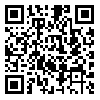BibTeX | RIS | EndNote | Medlars | ProCite | Reference Manager | RefWorks
Send citation to:
URL: http://tumj.tums.ac.ir/article-1-508-en.html
Background: Since the systemic steroids are introduced in Pemphigus Vulgaris treatment, the prognosis of disease improved significantly. This study was designed to evaluate determining factors in the prognosis of pemphigus vulgaris in Iranian patients.
Methods: In this study, 119 patients with documented pemphigus vulgaris who had presented to Razi Hospital from 2001 until 2003 were included. These patients had presented for the first time and treated with prednisolone and Azathioprine. Morality rate, minor and major relapses and duration of first remission had been defined as prognostic criteria and correlation between them and other demographic variables and disease characteristics were investigated.
Results: The majority of patients (84.1%) were followed for more than one year. The major recurrence and minor recurrence occurred in 28(23.5%) and 65(54.6%) of patients respectively, no case of mortality was observed. In patients who received treatment six months or less after onset of disease the frequency of major recurrence was less than the others. 18(17.8%) vs. 12(41.4%), (p=0.009). Duration of primary remission more than one year was detected in most of the patients (64.7%). In patients with less than 10 initial cutaneous lesions, period of primary remission was longer than the other patients. (p=0.009). Shorter duration of primary remission were noted in older patients (age>50) in comparison with younger patients (age≤50, p=0.04).
Conclusions: Male gender, old age, interval more than 6 months between onsets of symptoms to initial treatment and more than 10 skin lesions on admission, are associated with poor prognosis of pemphigus vulgaris.
| Rights and permissions | |
 |
This work is licensed under a Creative Commons Attribution-NonCommercial 4.0 International License. |





